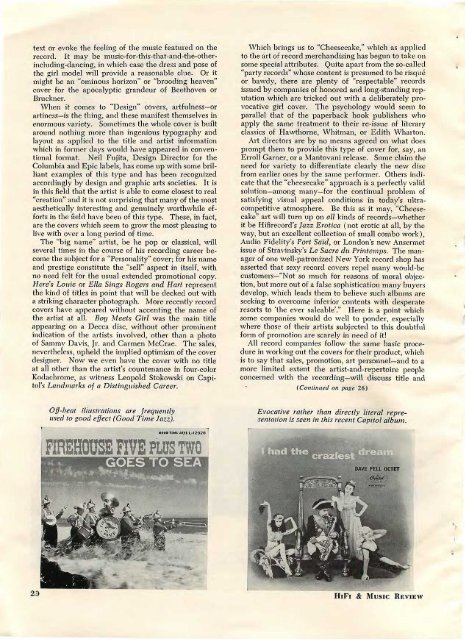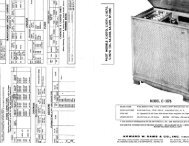~flr'6,r"®
Hifi Stereo Review â July 1958 - Vintage Vacuum Audio
Hifi Stereo Review â July 1958 - Vintage Vacuum Audio
- No tags were found...
Create successful ePaper yourself
Turn your PDF publications into a flip-book with our unique Google optimized e-Paper software.
text or evoke the feeling of the music featured on the<br />
record. It may be music-for-this-that-and-the-otherincluding-dancing,<br />
in which case the dress and pose of<br />
the girl model will provide a reasonable clue. Or it<br />
might be an "ominous horizon" or "brooding heaven"<br />
cover for the apocalyptic grandeur of Beethoven or<br />
Bruckner.<br />
When it comes to "Design" covers, artfulness-or<br />
artiness-is the thing, and these manifest themselves in<br />
enormous variety. Sometimes the whole cover is built<br />
around nothing more than ingenious typography and<br />
layout as applied to the title and artist information<br />
which in former days would have appeared in conventional<br />
format. Neil Fujita, Design Director for the<br />
Columbia and Epic labels, has come up with some brilliant<br />
examples of this type and has been recognized<br />
accordingly by design and graphic arts societies. It is<br />
in this field that the artist is able to come closest to real<br />
"creation" and it is not surprising that many of the most<br />
aesthetically interesting and genuinely worthwhile efforts<br />
in the field have been of this type. These, in fact,<br />
are the covers which seem to grow the most pleasing to<br />
live with over a long period of time.<br />
The "big name" artist, be he pop or classical, will<br />
several times in the course of his recording career become<br />
the subject for a "Personality" cover; for his name<br />
and prestige constitute the "sell" aspect in itself, with<br />
no need felt for the usual extended promotional copy.<br />
Here's Louie or Ella Sings Rogers and H mt represent<br />
the kind of titles in point that will be decked out with<br />
a striking character photograph. More recently record<br />
covers have appeared without accenting the name of<br />
the artist at all. Boy Meets Girl was the main title<br />
appearing on a Decca disc, without other prominent<br />
indication of the artists involved, other than a photo<br />
of Sammy Davis, Jr. and Carmen McCrae. The sales,<br />
nevertheiess, upheld the implied optimism of the cover<br />
designer. Now we even have the cover with no title<br />
at all other than the artist's countenance in four-color<br />
Kodachrome, as witness Leopold Stokowski on Capitol's<br />
Landmarks of a Distinguished Career.<br />
Which brings us to "Cheesecake," which as applied<br />
to the art of record merchandiSing has b egun to take Oll<br />
some special attributes. Quite apart from the so-called<br />
"party records" whose content is presumed to be risque<br />
or bawdy, there are plenty of "respectable" records<br />
issued by companies of honored and long-standing reputation<br />
which are tricked out with a deliberately provocative<br />
girl cover. The psychology would seem to<br />
parallel that of the paperback book publishers who<br />
apply the same treatment to their re-issue of literary<br />
classics of Hawthorne, Whitman, or Edith Wharton.<br />
Art directors are by no means agreed on what does<br />
prompt them to provide this type of cover for, say, an<br />
Erroll Gamer, or a Mantovani release. Some claim the<br />
need for variety to differentiate clearly the new disc<br />
from earlier ones by the same performer. Others indicate<br />
that the "cheesecake" approach is a perfectly valid<br />
solution-among many-for the continual problem of<br />
satisfying visual appeal conditions in to day's ultracompetitive<br />
atmosphere. Be this as it may, "Cheesecake"<br />
art will turn up on all kinds of records-whether<br />
it be Hifirecord's Jazz Erotica (not erotic at all, by the<br />
way, but an excellent collection of small combo work),<br />
Audio Fidelity's Port Said, or London's new Ansermet<br />
issue of Stravinsky's Le Sacre du Printemps. -The manager<br />
of one well-patronized New York record shop has<br />
asserted that sexy record covers repel many would-be<br />
customers-"Not so much for reasons of moral ob)ection,<br />
but more out of a false sophistication many buyers<br />
develop, which leads them to b elieve such albums are<br />
seeking to overcome inferior contents with desperate<br />
resorts to 'the ever saleable'." H ere is a point which<br />
some companies would do well to ponder, especially<br />
where those of their artists subjected to this doubtful<br />
form of promotion are scarely in need of it!<br />
All record companies follow the same basic procedure<br />
in working out the covers for their product, which<br />
is to say that sales, promotion, art personnel-and to a<br />
more limited extent the artist-and-repertoire p eople<br />
concerned with the recording-will discuss title and<br />
(Continued on page 26)<br />
Off-beat i!iustrations are frequently<br />
used to good effect (Good Time Jazz).<br />
Evocative rather than directly literal representation<br />
is seen in this recent Capitol album.<br />
HIFI & MUSIC REVIEW

















